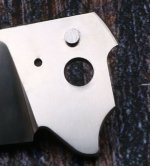Joe Holt
Plastic
- Joined
- May 14, 2016
So, I'd like to get some experience / thoughts on a press fit problem that I've been seeing. I'm pressing an 1/8 .1247 dowel pin into a reamed hole that is .1245 with a small arbor press. The containing part is a hardened (61c) M390 knife blade that is .130" thick. The hole is reamed before heat treating. I'm not really sure what size the hole is after heat treat. Presumably, there is some size change post heat treat. Most of the time, I'm able to press in the pin without issue. However, about every 10th blade or so it will break the blade. I use a drop of Wd40 to help the pin slide in hole. Do you guys have any idea what I'm doing wrong? Any help would be appreciated.
Thanks,
Joe

Thanks,
Joe


